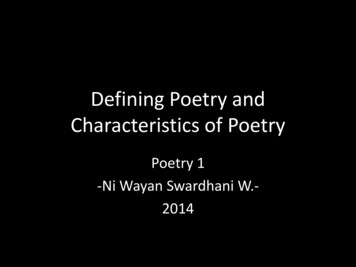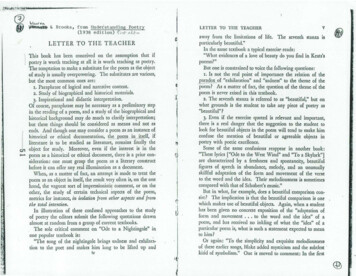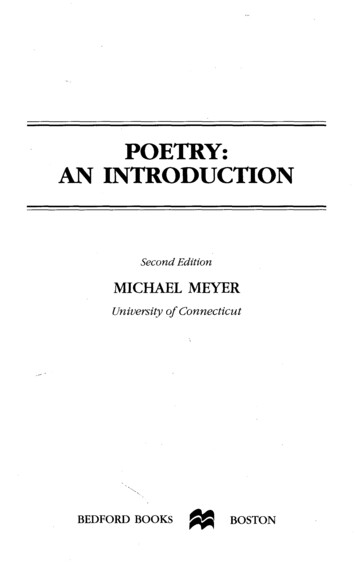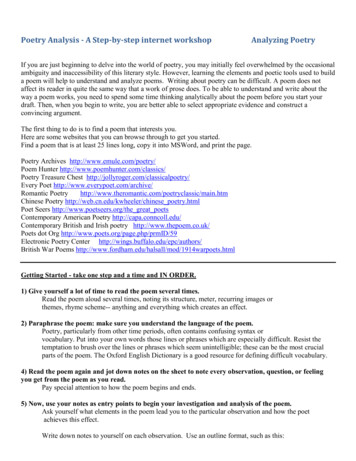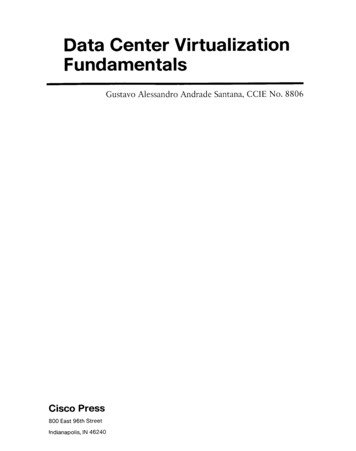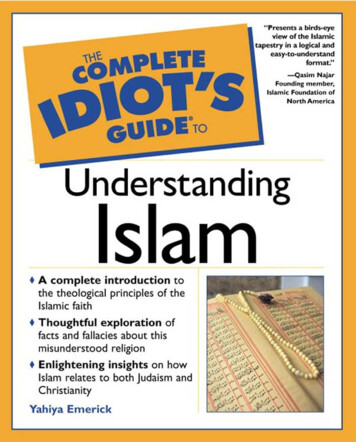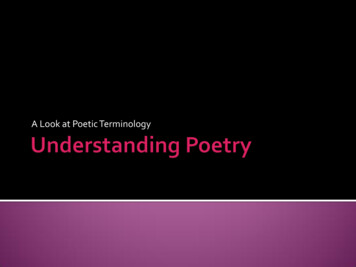
Transcription
Understanding Poetry
n n n In poetry the soundand meaning of wordsare combined toexpress feelings,thoughts, and ideas.The poet chooseswords carefully.Poetry is usuallywritten in lines.2
Poetry ElementsWriters use many elements to create theirpoems. These elements include:Rhythmn Soundn Imageryn Formn 3
Rhythmn n n n n Rhythm is the flow of thebeat in a poem.Gives poetry a musicalfeel.Can be fast or slow,depending on mood andsubject of poem.You can measure rhythmin meter, by counting thebeats in each line.(See next two slides forexamples.)4
Rhythm ExampleThe Pickety Fence by David McCordThe pickety fenceThe pickety fenceGive it a lick it'sThe pickety fenceGive it a lick it'sA clickety fenceGive it a lick it's a lickety fenceGive it a lickGive it a lickGive it a lickWith a rickety stickpicketypicketypicketypick.The rhythm in this poem is fast –to match the speed of the stickstriking the fence.5
Rhythm ExampleWhere Are You Now?When the night begins to fallAnd the sky begins to glowYou look up and see the tallCity of lights begin to grow –In rows and little golden squaresThe lights come out. First here, then thereBehind the windowpanes as thoughA million billion bees had builtTheir golden hives and honeycombsAbove you in the air.The rhythm in this poem isslow – to match the nightgently falling and thelights slowly coming on.By Mary Britton Miller6
SoundWriters love to use interesting sounds intheir poems. After all, poems are meant tobe heard. These sound devices include:Rhymen Repetitionn Alliterationn Onomatopoeian 7
Rhymen n n Rhymes are words thatend with the same sound.(Hat, cat and bat rhyme.)Rhyming sounds don’thave to be spelled thesame way. (Cloud andallowed rhyme.)Rhyme is the mostcommon sound device inpoetry.8
Rhyming Patternsn n Poets can choose froma variety of differentrhyming patterns.(See next four slidesfor examples.)n n n n AABB – lines 1 & 2 rhymeand lines 3 & 4 rhymeABAB – lines 1 & 3 rhymeand lines 2 & 4 rhymeABBA – lines 1 & 4 rhymeand lines 2 & 3 rhymeABCB – lines 2 & 4 rhymeand lines 1 & 3 do notrhyme9
AABB Rhyming PatternFirst SnowSnow makes whiteness where it falls.The bushes look like popcorn balls.And places where I always play,Look like somewhere else today.By Marie Louise Allen10
ABAB Rhyming PatternOodles of NoodlesI love noodles. Give me oodles.Make a mound up to the sun.Noodles are my favorite foodles.I eat noodles by the ton.By Lucia and James L. Hymes, Jr.11
ABBA Rhyming PatternFrom “Bliss”Let me fetch sticks,Let me fetch stones,Throw me your bones,Teach me your tricks.By Eleanor Farjeon12
ABCB Rhyming PatternThe AlligatorThe alligator chased his tailWhich hit him in the snout;He nibbled, gobbled, swallowed it,And turned right inside-out.by Mary Macdonald13
Repetitionn n n n n Repetition occurs whenpoets repeat words, phrases,or lines in a poem.Creates a pattern.Increases rhythm.Strengthens feelings, ideasand mood in a poem.(See next slide for example.)14
Repetition ExampleThe SunSome one tossed a pancake,A buttery, buttery, pancake.Someone tossed a pancakeAnd flipped it up so high,That now I see the pancake,The buttery, buttery pancake,Now I see that pancakeStuck against the sky.by Sandra Liatsos15
Alliterationn n Alliteration is therepetition of the firstconsonant sound inwords, as in thenursery rhyme “PeterPiper picked a peckof pickled peppers.”(See next slide forexample.)The snake slithered silentlyalong the sunny sidewalk.16
Alliteration ExampleThis ToothI jiggled itjaggled itjerked it.I pushedand pulledand poked it.But –As soon as I stopped,And left it aloneThis tooth came outOn its very own!by Lee Bennett Hopkins17
Onomatopoeian n n Words that represent theactual sound of somethingare words of onomatopoeia.Dogs “bark,” cats “purr,”thunder “booms,” rain“drips,” and the clock “ticks.”Appeals to the sense ofsound.(See next slide for example.)18
Onomatopoeia ExampleListenScrunch, scrunch, scrunch.Crunch, crunch, crunch.Frozen snow and brittle iceMake a winter sound that’s niceUnderneath my stamping feetAnd the cars along the street.Scrunch, scrunch, scrunch.Crunch, crunch, crunch.by Margaret Hillert19
Imageryn n n n Imagery is the use of wordsto create pictures, or images,in your mind.Appeals to the five senses:smell, sight, hearing, tasteand touch.Details about smells, sounds,colors, and taste createstrong images.To create vivid imageswriters use figures of speech.Five Senses20
Figures of Speechn n Figures of speech aretools that writers use tocreate images, or “paintpictures,” in your mind.Similes, metaphors, andpersonification are threefigures of speech thatcreate imagery.21
Similen n n A simile compares twothings using the words“like” or “as.”Comparing one thing toanother creates a vividimage.(See next slide forexample.)The runner streaked like a cheetah.22
Simile ExampleFlintAn emerald is as green as grass,A ruby red as blood;A sapphire shines as blue as heaven;A flint lies in the mud.A diamond is a brilliant stone,To catch the world’s desire;An opal holds a fiery spark;But a flint holds fire.By Christina Rosetti23
Metaphorn n n A metaphor comparestwo things without usingthe words “like” or “as.”Gives the qualities of onething to something that isquite different.(See next slide forexample.)The winter wind is a wolfhowling at the door.24
Metaphor ExampleThe Night is a Big Black CatThe Night is a big black catThe moon is her topaz eye,The stars are the mice she hunts at night,In the field of the sultry sky.By G. Orr Clark25
Personificationn n Personification giveshuman traits andfeelings to things thatare not human – likeanimals or objects.(See next slide forexample.)The moon smiled down at me.26
Personification ExampleFrom “Mister Sun”Mister SunWakes up at dawn,Puts his goldenSlippers on,Climbs the summerSky at noon,Trading placesWith the moon.by J. Patrick Lewis27
Forms of PoetryThere are many forms of poetry including the:n n n n n n n n n CoupletTercetAcrosticCinquainHaikuSenryuConcrete PoemFree VerseLimerick28
Lines and Stanzasn n n n Most poems arewritten in lines.A group of lines ina poem is called astanza.Stanzas separateideas in a poem.They act likeparagraphs.This poem has twostanzas.MarchA blue dayA blue jayAnd a good beginning.One crow,Melting snow –Spring’s winning!By Eleanor Farjeon29
Coupletn n A couplet is a poem,or stanza in a poem,written in two lines.Usually rhymes.The JellyfishWho wants my jellyfish?I’m not sellyfish!By Ogden Nash30
Tercetn n n A tercet is a poem, orstanza, written in threelines.Usually rhymes.Lines 1 and 2 canrhyme; lines 1 and 3 canrhyme; sometimes all 3lines rhyme.Winter MoonHow thin and sharp is the moon tonight!How thin and sharp and ghostly whiteIs the slim curved crook of the moon tonight!By Langston Hughes31
Quatrainn n n n n A quatrain is a poem, orstanza, written in fourlines.The quatrain is the mostcommon form of stanzaused in poetry.Usually rhymes.Can be written in varietyof rhyming patterns.(See slide 9 entitled“Rhyming Patterns.”)The LizardThe lizard is a timid thingThat cannot dance or fly or sing;He hunts for bugs beneath the floorAnd longs to be a dinosaur.By John Gardner32
Traditional Cinquainn n A cinquain is a poemwritten in five lines that donot rhyme.Traditional cinquain hasfive lines containing 22syllables in the followingpattern:Line 1 – 2 syllablesLine 2 – 4 syllablesLine 3 – 6 syllablesLine 4 – 8 syllablesLine 5 – 2 syllablesOh, catare you grinningcurled in the window seatas sun warms you this Decembermorning?By Paul B. Janezco33
Word-Count Cinquainn Word-count cinquain for youngerstudents uses the followingpattern:Line 1: One word (title)Line 2: Two words (describe thetitle)Line 3: Three words (describe anaction)Line 4: Four words (describe afeeling)Line 5: One word (another word fortitle)OwlSwift, ferociousWatches for foodSoaring through the nightHunter34
Diamanten n n n n A diamante is a sevenline poem written in theshape of a diamond.Does not rhyme.Follows pattern.Can use synonyms orantonyms.(See next two slides forexamples.)Diamante PatternLine 1 – Your topic (noun)Line 2 – Two adjectives aboutLine 3 – Three “ing” words aboutLine 4 – Four nouns or shortphrase linking topic (or topics)Line 5 – Three “ing” words aboutLine 5 – Two adjectives aboutLine 7 – Your ending topic (noun)35
Synonym DiamanteMonstersCreepy, sinister,Hiding, lurking, stalking,Vampires, mummies, werewolves and more –Chasing, pouncing eating,Hungry, scary,Creatures36
Antonym DiamanteDayBright, sunny,Laughing, playing, doing,Up in the east, down in the west –Talking, resting, sleeping,Quiet, dark,Night37
Haikun n n n A haiku is a Japanesepoem with 3 lines of 5, 7,and 5 syllables. (Total of17 syllables.)Does not rhyme.Is about an aspect ofnature or the seasons.Captures a moment intime.Little frog amongrain-shaken leaves, are you, too,splashed with fresh, green paint?by Gaki38
Senryun n n A senryu follows samepattern as haiku.Written in 3 unrhymedlines of 5, 7, and 5syllables, with total of 17syllables.Is about human nature,rather than natural world.First day, new school year,backpack harbors a fossil last June’s cheese sandwich.By Cristine O’Connell George39
Concrete Poemn n n A concrete poem (alsocalled shape poem) iswritten in the shape ofits subject.The way the words arearranged is as importantwhat they mean.Does not have to rhyme.40
Free Versen n A free verse poemdoes not use rhyme orpatterns.Can vary freely inlength of lines,stanzas, and subject.RevengeWhen I find outwho tookthe last cookyout of the jarand leftme a bunch ofstale old messycrumbs, I'mgoing to takeme a handfuland crumbup someone's bed.By Myra Cohn Livingston41
Acrosticn n n In an acrostic poemthe first letter of eachline, read down thepage, spells thesubject of the poem.Type of free versepoem.Does not usuallyrhyme.Loose brown parachuteEscapingAndFloating on puffs of air.by Paul Paolilli42
Limerickn n n n n A limerick is a funnypoem of 5 lines.Lines 1, 2 & 5 rhyme.Lines 3 & 4 areshorter and rhyme.Line 5 refers to line 1.Limericks are a kindof nonsense poem.There Seems to Be a ProblemI really don’t know about Jim.When he comes to our farm for a swim,The fish as a rule,jump out of the pool.Is there something the matter with him?By John Ciardi43
Nonsense Poemsn n A nonsense poem is ahumorous poem withsilly characters andactions. It is meant tobe fun.Can be written as alimerick or as anotherform of poetry.A Princess LamentsI kissed a frog because I’d heardThat it would turn into a prince.That’s not exactly what occurred,And I’ve been croaking ever since.by Jack Prelutsky44
Word Playn Some poets use aspecial kind of wordplay by making upwords or misspellingthem on purpose.The WalrusThe pounding spatterOf salty seaMakes the walrusWalrusty.By Douglas Florian45
VoiceHello!Hi!“Voice” is the speaker in a poem. The speakercan be the poet himself or a character he createdin the poem. There can be one speaker or manyspeakers.n n n n Poet as speaker (slides 47-49)Human character in poem as speaker (slide 50)Object or animal as speaker (slides 51-52)More than one speaker (slides 53-54)46
Voice: Poet as SpeakerThe WindWho has seen the wind?Neither I nor you:But when the leaves hang tremblingThe wind is passing thro’.Who has seen the wind?Neither you nor I:But when the trees bow down their heads,The wind is passing by.by Christina RosettiIn this poem, the poetspeaks of her feelingsabout the power of thewind.47
Voice: Poet as SpeakerThe Sugar LadyThere is an old lady who lives down the hall,Wrinkled and gray and toothless and small.At seven already she’s up,Going from door to door with a cup.“Do you have any sugar?” she asks,Although she’s got more than you.“Do you have any sugar?” she asks,Hoping you’ll talk for a minute or two.by Frank AschIn this poem, the poet tellsa story about a lonely oldwoman hoping to talk.48
Voice: Poet as SpeakerCloudsWhite sheep, white sheep,On a blue hill,When the wind stopsYou all stand still.When the wind blowsYou walk away slow.White sheet, white sheep,Where do you go?In this poem, the poet speaks toclouds - something that cannotanswer back. She uses ametaphor when she calls theclouds “white sheep.”by Christina Rosetti49
Voice: Human Character as SpeakerFor KeepsWe had a tug of war todayOld March Wind and I.He tried to steal my new red kiteThat Daddy helped me fly.He huffed and puffed.I pulled so hardAnd held that string so tightOld March Wind gave up at lastAnd let me keep my kite.by Jean Conder SouleIn this poem, the voice isthat of a child flying a kiteon a windy day. The childis the character in thepoem.50
Voice: Object as SpeakerCrayon DanceThe cardboard ceiling liftsPickmepickmepickme, I prayThe fingers do! They choose me,Sky Blue!Hurrah! Hooray!by April Halprin WaylandIn this poem, the voice is thatof a blue crayon, happy to bepicked by the artist. Thecrayon is the character in thepoem.51
Voice: Animal as SpeakerTurtle in JulyHeavyHeavy hotHeavy hot hangsThick stickyIckyBut I lieNose highCool poolNo foolA turtle in JulyIn this poem, the voice is that of aturtle keeping cool on a hot Julyday. The turtle is the character inthe poem.by Marilyn Singer52
Voice: Two SpeakersI Talk With the MoonI talk with the moon, said the owlWhile she lingers over my treeI talk with the moon, said the owlAnd the night belongs to me.I talk with the sun said the wrenAs soon as he starts to shineI talk with the sun, said the wrenAnd the day is mine.There are two voices in thispoem. In the first stanza thevoice is that of the night-timeowl. In the second stanza thevoice is that of the day-timewren.By Beverly McLoughland53
Voice: Multiple SpeakersMonster MothersBy Florence Parry HeideWhen monster mothers get togetherThey brag about their babies.The other day I heard one say,“He’s got his very first fang today!”“Mine is ugly.”“Mine is
Understanding Poetry . 2 ! In poetry the sound and meaning of words are combined to express feelings, thoughts, and ideas. ! The poet chooses words carefully. ! Poetry is usually written in lines. 3 Poetry Elements ! Rhythm ! Sound ! Imagery ! Form Writers use many elements to create their poems. These elements include: 4 Rhythm ! Rhythm is the flow of the beat in a poem. ! Gives poetry a .
